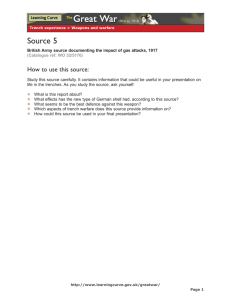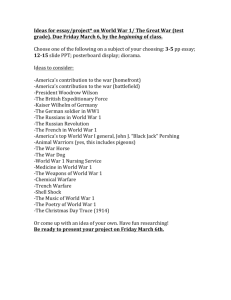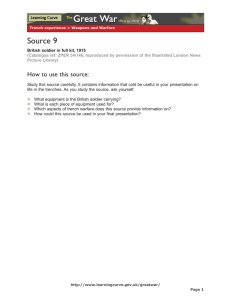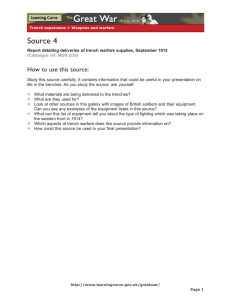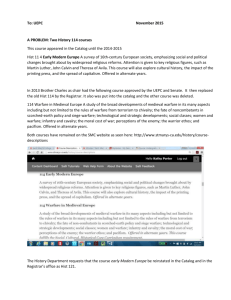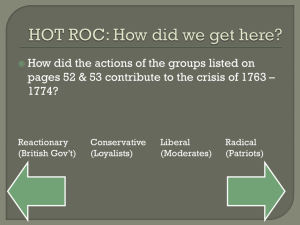Chapter 18 HISTORICAL OVERVIEW OF BIOLOGICAL WARFARE
advertisement
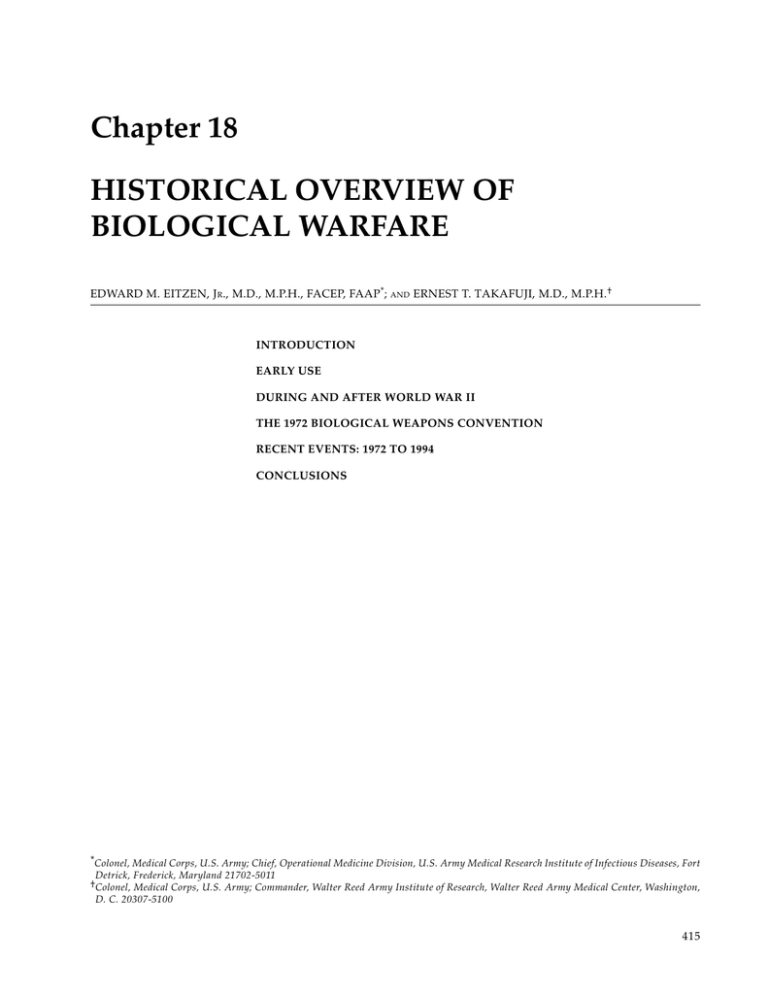
Historical Overview of Biological Warfare Chapter 18 HISTORICAL OVERVIEW OF BIOLOGICAL WARFARE EDWARD M. EITZEN, J R., M.D., M.P.H., FACEP, FAAP*; AND ERNEST T. TAKAFUJI, M.D., M.P.H. † INTRODUCTION EARLY USE DURING AND AFTER WORLD WAR II THE 1972 BIOLOGICAL WEAPONS CONVENTION RECENT EVENTS: 1972 TO 1994 CONCLUSIONS * Colonel, Medical Corps, U.S. Army; Chief, Operational Medicine Division, U.S. Army Medical Research Institute of Infectious Diseases, Fort Detrick, Frederick, Maryland 21702-5011 † Colonel, Medical Corps, U.S. Army; Commander, Walter Reed Army Institute of Research, Walter Reed Army Medical Center, Washington, D. C. 20307-5100 415 Medical Aspects of Chemical and Biological Warfare INTRODUCTION The possibility that biological weapons will be used against us is no longer unthinkable. Until recently, medical officers and other healthcare practitioners may have considered this topic more suitable for academic than practical pursuit. The fact is, however, that biological agents have been used as weapons since antiquity, and the threat that modern weapons will be used is real. In fact, Saddam Hussein’s aggression in the Persian Gulf War may have provided our nation with a wake-up call. The importance of education regarding this unpalatable subject cannot be overestimated. Before our soldiers deploy again against an aggressor likely to use biological weapons, our military healthcare providers need to be confident that they understand both the threat and the medical countermeasures to the threat. This chapter and the ones that follow will help meet that need. EARLY USE Warfare with biological weapons has been attempted many times dating back to antiquity. It is appropriate that a discussion of early use of biological agents begin with the accomplishment of Hannibal, the great Carthaginian leader, who, in preparation for a naval battle against King Eumenes of Pergamum in 184 BC, ordered that earthen pots 1(p12) be filled with “serpents of every kind.” During the heat of battle, Hannibal hurled the earthen pots onto the decks of the puzzled Pergamene warriors, who remained amused only until they saw their ships crawling with serpents. The battle was won by Hannibal’s forces, as the Pergamene soldiers 1 battled two enemies. Recognition of the devastating impact that infectious diseases could have on an army resulted in the often crude but ingenious use of disease organisms and poor sanitation to weaken the enemy. The use of corpses of men and animals to pollute wells and other sources of water of the opposing forces was a common strategy. The fouling of water supplies continued to be used through the many European wars, the American Civil War, and into the 20th century. 1,2 In his Memoirs, General W. T. Sherman expressed discontent with Confederate troops, who were deliberately shooting farm animals in ponds so that their “stinking carcases”1(p12) would compromise the water supplies of the Union forces. Not only did such actions have a demoralizing impact on the enemy, but the consumption of contaminated water probably also accounted for many undocumented epidemics of gastrointestinal disease. Military leaders during the Middle Ages recognized that victims of infections could become weapons in themselves. Gabriel de Mussis, a notary, saw the Tatar attack on Caffa, a well-fortified, Genoesecontrolled seaport (modern Feodosiya, Ukraine), in 1346. De Mussis described how the plague-weak416 ened aggressors catapulted victims of plague into the town: [The Tatars], fatigued by such a plague and pestiferous disease, stupefied and amazed, observing themselves dying without hope of health ordered cadavers placed on their hurling machines and thrown into the city of Caffa, so that by means of these intolerable passengers the defenders died widely. 3(p180) An epidemic of plague followed, forcing a retreat of the Genoese forces. The exported disease continued to spread in Europe.4,5 During the Black Plague, which killed 25 million Europeans in the 14th and 15th centuries, bodies of dead soldiers and “2,000 cartloads of excrement”6(p59) were hurled into the ranks of the enemy at Carolstein in 1422. A similar strategy was used in 1710, when Russian troops battling Swedish forces in Reval resorted to throwing plague victims over the city walls.2 On several occasions, smallpox has been used as a biological weapon in the New World. Pizarro is said to have presented indigenous peoples of South American with variola-contaminated clothing in the 15th century, and the English did the same when Sir Jeffery Amherst provided Indians loyal to the French with smallpox-laden blankets during the French and Indian War (1754–1767). Native Americans defending Fort Carillon sustained epidemic casualties that directly contributed to the loss of the fort to the English.7 In 1763, Captain Ecuyer of the Royal Americans, out of concern that an Indian attack was possible in the near future and under the pretense of friendship, deliberately distributed two variola virus–contaminated blankets and a handkerchief from a smallpox hospital to enemy Indian forces. 5,8,9 This was followed several months later by large outbreaks of smallpox among various Historical Overview of Biological Warfare Indian tribes in the Ohio region. A similar strategy (deliberately infecting adversaries with variola virus) was used during the Revolutionary War by smallpox-immune colonists, whose vaccinations against smallpox had been made mandatory by General George Washington.2,10 Biological warfare became more sophisticated during the 1900s—against both humans and animals. During World War I, reports circulated of attempts by the Germans to ship horses and cattle inoculated with disease-producing bacteria, such as Bacillus anthracis (the bacterium that causes anthrax) and Pseudomonas pseudomallei (the bacterium that causes glanders in livestock), to the United States and elsewhere.2 This accusation was difficult to substantiate, since glanders was widespread in Europe at the time. However, a German saboteur, who supposedly infected 4,500 mules with glanders, was arrested in 1917 in Mesopotamia.2,5 Other allegations of attempts by Germany to spread cholera in Italy and plague in St. Petersburg, Russia, in 1915 followed; the dropping of contaminated fruit, chocolate, and children’s toys into Romanian cities such as Bucharest by German planes was also alleged.2 Germany denied all allegations, including the accusation that biological bombs were being dropped over British positions. In 1924, a subcom- mittee of the Temporary Mixed Commission of the League of Nations, in support of Germany, stated that, in contradistinction to the chemical arm, there was no hard evidence that the bacteriological arm had been employed in war.2 On 17 June 1925, the Protocol for the Prohibition of the Use in War of Asphyxiating, Poisonous or Other Gases and of Bacteriological Methods of Warfare, commonly called the Geneva Protocol of 1925, was signed. This was the first multilateral agreement that extended prohibition of chemical agents to biological agents.2,5 Since viruses were not differentiated from bacteria at the time, they were not specifically mentioned in the protocol. However, subsequent interpretations of the agreement considered the term “bacteriological” to include viruses, rickettsiae, and fungi, and to be synonymous with the term “biological.” A total of 108 nations, eventually including the five permanent members of the United Nations Security Council, signed the agreement, which became known as the Geneva Protocol. Nations currently implicated with chemical and biological weapons (ie, Iraq and Libya) also signed the protocol, raising questions about the agreement’s true effectiveness. Verification of compliance was not addressed. DURING AND AFTER WORLD WAR II Events during and after World War II were clouded by charges and countercharges of experimentation with biological warfare agents. The Japanese were accused of using biological agents against the Soviet Union and Mongolia in 1939, against Chinese civilians from 1940 to 1944, and against Chinese troops in 1942.2,5 In October 1940, a Japanese plane supposedly scattered contaminated rice and fleas over the city of Chuhsien in Chekiang province. This event was soon followed by an outbreak of bubonic plague, a disease never recorded previously in Chuhsien. Several other mysterious flights of Japanese aircraft over at least 11 Chinese cities—with the dropping of grain (wheat, rice, sorghum, or corn), strange granules containing Gram-negative bacilli, and other materials suspected of being contaminated with the plague organism—took place through August 1942. Thousands are estimated to have been hospitalized and 700 became victims of artificially spread plague bacilli.5 However, despite compelling evidence, testimony, and documents, failure to associate directly the isolation of plague bacilli in the laboratory with actual materials dropped by the planes made pros- ecution difficult. It is worth noting that a Japanese document dated 1 October 1941, “Defense and Security Intelligence Report No. 8: Chinese Employment of Chemical and Bacteriological Warfare Against the Japanese,” revealed a paranoia about secret Chinese initiatives: There is evidence that during the China Incident the enemy has skillfully and secretly carried out chemical and bacteriological warfare activities against personnel, animals, natural resources, water and food supplies. It may be presumed that the enemy will become increasingly active in such methods. Therefore, security and defense measures must be thorough during advances and halts.2(p221) At least 3,000 prisoners of war (including Chinese, Koreans, Mongolians, Soviets, Americans, British, and Australians) are alleged to have been used as guinea pigs by Japan’s Imperial Unit 731.2,11 Conservatively, more than 1,000 of these prisoners are estimated to have died in experiments with agents causing anthrax, botulism, brucellosis, cholera, dysentery, gas gangrene, meningococcal infection, and plague.2 Experiments with tetrodotoxin 417 Medical Aspects of Chemical and Biological Warfare (highly poisonous fugu toxin) were also conducted. These experiments were later considered to be “most regrettable from the view point of humanity”11(p11) by the Japanese government. In fact, Japan had been conducting experiments on biological and chemical warfare in occupied Manchuria from approximately 1932 until the end of World War II. There were actually several special Japanese experimental units in Manchuria, including the more infamous Units 731 and 100.12 Unit 731 was formed to prepare for biological warfare, and Unit 100’s purpose was to ready bacteriological weapons for use.13 Experimental work on human prisoners was carried out in Ping Fan outside Harbin (Unit 731), Changchun, Nanking, and other sites. The number of people exterminated at Ping Fan alone is estimated to have been more than 3,000. Subjects either died in the experiments or were “sacrificed” when they were no longer useful to the Japanese. 12 The Japanese death factories may also have led to the epidemics of plague that occurred in the Harbin area after World War II, possibly due to the release of thousands of infected animals during the Japanese evacuation in 1945.12 No prisoner left Unit 731 alive.13 In December 1949, 12 Japanese prisoners of war, including the Commander in Chief of the Japanese Kwantung Army, were tried by a Soviet military tribunal in Khabarovsk, USSR, for preparing and using biological weapons, including agents causing plague, typhoid, paratyphoid, and typhus. 11 Major General Kawashima, former head of Unit 731’s First, Third, and Fourth Sections, testified that no fewer than 600 prisoners were killed yearly at Unit 731.12 The Japanese, in turn, accused the Soviets of experimentation with biological warfare agents, citing, as an example, glass bottles and ampules containing Shigella (bacillary dysentery), Bacillus anthracis (anthrax), and Vibrio cholerae (cholera) organisms recovered from Russian spies.2 Although German medical researchers during World War II experimentally infected prisoners with disease-producing organisms such as Rickettsia prowazeki, R mooseri, hepatitis A virus, and malaria, no charges were pressed at the conclusion of the war. In December 1941, the British reported finding Colorado beetles in areas of the United Kingdom in which they were not normally found, and suggested that they might have been released by the Germans. 14 In May 1945, apparent intentional fecal pollution of a large reservoir in northwestern Bohemia caused an outbreak of dysentery.2 However, an offensive biological warfare program by Nazi Germany could never be documented, al418 though some in the Third Reich were interested in developing an adequate defense against biological agents.2 On the other hand, the Germans also accused the Allies of using biological weapons, causing a widespread plague of Colorado beetles on their potato crops.14 Dr. Joseph Goebbels, German Minister of Propaganda, also accused the British of attempting to introduce yellow fever into India by transporting infected mosquitoes from West Africa.7 This was believable to many, for the British were indeed experimenting with at least one biological agent during 1941 and 1942. British trials with Bacillus anthracis were held on Gruinard Island off the coast of Scotland. The small bomb experiments resulted in heavy contamination: persistent anthrax spores contaminated parts of the island for many years.8,15 Winston Churchill is said to have seriously considered using anthrax if Nazi Germany used biological agents against Britain.5 During the years immediately following World War II, newspapers were filled with articles of disease outbreaks supposedly caused by foreign agents armed with biological weapons.2 Outbreaks of cholera in Egypt in 1947 were reportedly caused by Zionist infiltrators. In 1951, a Soviet navy newspaper reported that the United States had tested biological weapons against Eskimos in Canada, leading to an epidemic of plague in 1949. In 1950, East Germany accused the United States of spreading Colorado beetles over parts of Germany. During the Korean War, the Soviet Union, China, and North Korea accused the United States of using biological warfare against North Korea and China.2,16 In 1952, an international group of scientists—formed as a result of North Korean complaints—concluded that tests of bacteriological weapons were being conducted against North Korea and China. These experiments supposedly included mosquitoes carrying yellow fever virus and other means of disseminating infectious agents. The United States admitted that it had the capability to produce biological agents but denied conducting germ warfare. The International Red Cross suggested that a special commission be created to investigate the charges, but the request was refused by the Chinese and the Koreans.8,17 There is a total lack of scientific basis for these allegations, and at least one American military historian 18 believes that the charges were blatant propaganda. Epidemics occurred in North Korea and China not because biological warfare attacks were perpetrated by the United States but because the devastation of “war caused a collapse of the mea- Historical Overview of Biological Warfare ger health system. The [biological warfare] propaganda was an attempt to conceal the inability to control epidemics.”18(p97) Moreover, recent access to material from the Korean War era, contained in the Archives of the Polish Academy of Science, sheds additional new light on allegations that biological warfare attacks were launched against North Korea and China. Among the official documents now available to western investigators is a letter, written when the allegations of biological warfare were at their height, containing a request from the Korean government that Polish funds be redirected. Amazingly, the Korean request was that Polish funds be used to pay for clothing instead of the sera and vaccines that the Koreans had been receiving. “This letter, dated August 1952, at the height of the [biological warfare] propaganda, casts doubt on the widely advertised existence of biological warfare at that time.”17(p98) Other events and allegations included the following2: • accusations by the Eastern European press that Britain used biological agents in Oman in 1957; • Brazilian landowners’ deliberate infection of Indian tribes in 1970, to remove them from parts of the Amazon; • Chinese accusations that the United States started a cholera epidemic in Hong Kong in 1961; • accusations in July 1964 by the Soviet newspaper Pravda that Colombian troops and the U.S. Military Commission in Colombia had used biological agents against the peasants of Colombia and Bolivia; and • accusations in 1969 by Egyptians that the “imperialist aggressors” had used biological warfare agents in the Middle East, specifically cholera in Iraq in 1966. In 1970, South Korea maintained that North Korea was planning to launch a biological warfare attack, based on a North Korean facility’s placing a large order from a Japanese trading firm for anthrax, cholera, and plague bacteria. Although the situation was peacefully resolved, biological warfare merely provided one more issue on which North and South Korea could disagree and distrust each other. During the Vietnam War in the 1960s, many considered the use of fecally contaminated spear traps (“pungi sticks”) to be the Vietcong’s adaptation of biological warfare. Emphasis in that conflict was largely on conventional warfare and special operations in the jungles of Southeast Asia, although concern continued over endemic and artificially introduced infectious agents. “Yellow rain” (which is discussed in Chapter 34, Trichothecene Mycotoxins) became an issue later, along with controversies surrounding use of the chemical herbicide Agent Orange (an approximately 50%–50% mixture of dichlorophenol [2,4-D] and trichlorophenol 2,4,5-T, with trace amounts of the contaminant 2,3,7,8 tetrachlorodibenzo-p-dioxin [TCDD]). In November 1969, the World Health Organization of the United Nations issued a report on chemical and biological weapons. This report (and an earlier report by the 18-Nation Committee on Disarmament) described the unpredictability of biological warfare weapons and the attendant risks and lack of control when such weapons are used. The effectiveness of biological weapons was not questioned; estimated casualty figures were staggering.19 In July 1969, Great Britain submitted a recommended statement to the Conference of the Committee on Disarmament prohibiting the “development, production, and stockpiling of bacteriological (biologic) and toxin weapons.”20(p116) Then in September 1969, the Soviet Union unexpectedly recommended a disarmament convention to the United Nations General Assembly. THE 1972 BIOLOGICAL WEAPONS CONVENTION As a follow-on to the 1925 Geneva Protocol, the 1972 Convention on the Prohibition of the Development, Production, and Stockpiling of Bacteriological (Biological) and Toxin Weapons and on their Destruction, commonly known as the Biological Weapons Convention, was convened.2,5 Agreement was eventually reached among the 103 co-signing nations never to develop, produce, stockpile, or otherwise acquire or retain microbial or other biological agents or toxins, whatever their origin or method of production, of types and in quantities that have no justification for prophylactic, protective or other peaceful purposes; and weapons, equipment or means of delivery designed to use such agents or toxins for hostile purposes or in armed conflict.5(p135) The agreement went into effect in March 1975 and reduced the concerns that some nations had over the development and use of biological agents. However, problems with verification and the interpretation of “defensive” research continued. 419 Medical Aspects of Chemical and Biological Warfare Every year, signatories to the agreement are required to submit to the United Nations information on • facilities where biological defense research is being conducted; • scientific conferences that are held at specified facilities; • exchanges of scientists or information; and • disease outbreaks. The Security Council, of which the United States and Russia are members, reserves the right to veto any request for an investigation, should any allegations of infractions be lodged with the United Nations. In 1986 and again in September 1991, review conferences were held to resolve continuing problems. RECENT EVENTS: 1972 TO 1994 Since the signing of the Biological Weapons Convention in 1972, the U.S. intelligence community has identified many significant events and emerging threats in the area of offensive biological warfare. The number and identity of countries engaged in offensive biological warfare work is classified; however, we can accurately state that the number of state-sponsored programs of this type has increased significantly. Also, several terrorist or assassination attacks have been documented. On April 3, 1979, a mysterious explosion at the Soviet Institute of Microbiology and Virology in Sverdlovsk raised questions about the effectiveness of any weapons-control agreements.5,21,22 At least 66 persons, most of them civilians (the area affected was downwind of the military compound), are believed to have been killed (most with inhalation anthrax), and many more to have been infected with Bacillus anthracis. For years, the Soviets maintained that this incident had not been due to an accidental release of anthrax from the military research facility, but instead was due to ingestion by the local residents of contaminated animal products. Controversy raged back and forth in the lay press over the incident. Finally, in 1992, the President of Russia, Boris Yeltsin, admitted that there had, in fact, been an accidental airborne release of anthrax spores from the research facility in question, confirming the long-held belief of many in the United States.23 (This incident is discussed more fully in Chapter 22, Anthrax.) In 1978, before the Sverdlovsk incident, a Bulgarian exile named Georgi Markov was attacked in London, England, with a device disguised as an umbrella (Figure 18-1). This weapon discharged a tiny pellet (Figure 18-2) into the subcutaneous tissue of his leg while he was waiting for a bus. He died several days later. On autopsy, the pellet, crossdrilled as if designed to be filled with another material, was found. This assassination, it was later revealed, was carried out by the communist Bulgarian government, and the technology to commit 420 the crime was supplied to the Bulgarians by the Soviet Union.7 (This incident is discussed more fully in Chapter 32, Ricin Toxin.) Another attempted killing of another Bulgarian exile, Vladimir Kostov, had occurred in Paris, France, 10 days before the Markov assassination. Kostov was a defector who worked for Radio Free Europe, broadcasting opposition to the Bulgarian government. As he was leaving a metro stop in Paris, Kostov felt a sharp pain in his back. Turning quickly, he observed a man with an umbrella running away.24 Only the heavy clothing worn by Kostov prevented the pellet shot at him from penetrating any deeper than the subcutaneous tissue of his back.25 The pellet remained in Kostov’s back until after he learned of Markov’s death, about 2 weeks later, whereupon French doctors examined his back. They removed a similar pellet, which was made from an exotic alloy of iridium and platinum and contained the toxin ricin, in time to save Kostov’s life. The ri- Release Catch Trigger Spring Gas Cylinder Piercer Poison Pellet Barrel Fig. 18-1. An umbrella gun of this type was the clandestine weapon used to assassinate Bulgarian exile Georgi Markov in London in 1978. The weapon consisted of a spring-loaded piston, which would drive a carbon dioxide cartridge forward into a firing pin. The gas would then propel a poison projectile out of the hollow tip of the umbrella gun, through the clothing, and into the flesh of the intended victim. Reprinted from van Keuren RT. Chemical and Biological Warfare, An Investigative Guide. Washington, DC: Office of Enforcement, Strategic Investigations Division, US Customs Service; October 1990: 89. Historical Overview of Biological Warfare Fig. 18-2. A pellet of this type, designed to contain ricin toxin, was used to assassinate Georgi Markov in London and in the attempt on the life of Vladimir Kostov in Paris. The tiny, platinum–iridium pellet—the size of the head of a pin (0.068 in. diameter)—was cross-drilled with 0.016-in. holes in which ricin (or another toxin) could be placed. Reprinted from van Keuren RT. Chemical and Biological Warfare, An Investigative Guide. Washington, DC: Office of Enforcement, Strategic Investigations Division, US Customs Service; October 1990: 90. cin was kept in the pellet by a wax plug designed to melt at body temperature. Fortunately for Kostov, the wax did not melt. Similar pellet-firing weapons may have been responsible for at least six assassinations in recent years.26 In addition, an attempted assassination with ricin may have occurred in the United States—in a shopping mall parking lot in Tyson’s Corner, Virginia27—although this incident is less well documented than the two previous ones. In the late 1970s, there were indications that inhabitants of Laos and Kampuchea may have been attacked by planes and helicopters delivering aerosols of several colors. After being exposed, people and animals allegedly became disoriented and ill, and a small percentage of those stricken died. Some of these clouds were thought to be comprised of trichothecene toxins (in particular, T-2 mycotoxin). These attacks are lumped under the label “yellow rain.” A great deal of controversy has raged over whether these clouds were in fact biological warfare agents. Some28 in the scientific community have summarized the available evidence and concluded that the yellow rain was most likely the fecal matter of wild honeybees dropped during their “cleansing flights.” Others believe that “there is enough evidence to make agent use in these reported attacks highly probable.”7(p100) The controversy remains unresolved. For a more complete discussion, see Chapter 34, Trichothecene Mycotoxins. During Operation Desert Shield, the build-up phase of the Persian Gulf War (fall and winter, 1990) after Iraq invaded and occupied Kuwait, the United States and the coalition of allies faced the threat of biological and chemical warfare. Fortunately, Saddam Hussein did not use unconventional weapons, but the allies believe that he retained this capability after his defeat. In August 1991, the first United Nations inspection of Iraq’s biological warfare capabilities was carried out in the aftermath of the Persian Gulf War. On 2 August 1991, representatives of the Iraqi government announced to leaders of United Nations Special Commission Team 7 (of which one of the authors, E.M.E., was a member) that Iraq had conducted research into the offensive use of Bacillus anthracis, botulinum toxins, and Clostridium perfringens (presumably one of its toxins). This was the first open admission in recent memory of biological weapons research by any country, and it publicly verified many of the concerns of the U.S. intelligence community. Iraq had extensive and redundant research facilities at Salman Pak, Al Hakam, and other sites, only some of which were destroyed during the Persian Gulf War. Subsequent United Nations inspections have further elucidated Iraqi biological warfare intentions, identified some of the Iraqi capabilities, and, we hope, decreased the likelihood that Iraq will use biological warfare in future conflicts. However, since the defection of Iraqi General Hussein Kamal Hassan on 7 August 1995, it has become clear that the Iraqi biological warfare program was even further advanced than United Nations inspectors had suspected. Iraq has disclosed in the wake of Hussein’s defection that it had actually filled biological warfare agents into weapons immediately before the outbreak of the Persian Gulf War. These weapons included the following29: • 166 bombs (100 botulinum toxin, 50 anthrax, 16 aflatoxin); • 25 Scud/A1 Hussein missile warheads (13 botulinum toxin, 10 anthrax, 2 aflatoxin); • 122-mm rockets filled with anthrax, botulinum toxin, and aflatoxin; 421 Medical Aspects of Chemical and Biological Warfare • spray tanks capable of being fitted to a fighter aircraft or remotely piloted aircraft, and spraying 2,000 L over a target; and • artillery shells. It is now clear that U.S. forces faced a significant biological warfare capability in the desert in this decade. Fortunately, Iraq chose not to use biological weapons against us. CONCLUSIONS The threat of biological warfare has increased over the past 2 decades, with a number of countries working on offensive use of these agents. The extensive program of the former Soviet Union is now controlled largely by Russia. Admitting that a biological warfare program existed until early 1992—nearly 20 years after the USSR signed the Biological Weapons Convention in 1972—Russian president Boris Yeltsin has stated23 that he will put an end to further offensive biological research. However, the degree to which the program has been scaled back is not known. There is intense concern in the West about the possibility of proliferation or enhancement of offensive programs in countries hostile to the western democracies, due to the potential hiring of expatriate Russian scientists. There is also a certain amount of concern over the possibility that terrorists might use biological agents to threaten either military or civilian populations. Certainly the threat that biological weapons will be used against U.S. military forces is broader and more likely in various geographic scenarios now than it has been at any point in our history. REFERENCES 1. Rothschild JH. Tomorrow’s Weapons. New York, NY: McGraw-Hill; 1964. 2. Stockholm International Peace Research Institute (SIPRI). The Rise of CB Weapons. Vol 1. In: The Problem of Chemical and Biological Warfare. New York, NY: Humanities Press; 1971. 3. De Mussis G. Historica de Morbo s. Mortalitate quae fuit Anno Dni MCCCXLVIII. Cited in: Derbes VJ. De Mussis and the great plague of 1348: A forgotten episode of bacteriological warfare. JAMA. 1966;196(1):179-182. 4. Derbes VJ. De Mussis and the great plague of 1348: A forgotten episode of bacteriological warfare. JAMA. 1966;196(1):59–62. 5. Geissler E, ed. Biological and Toxin Weapons Today. Oxford, England: Oxford University Press, Stockholm International Peace Research Institute; 1986. 6. Varillas. Historie de l’Hérésie de Viclef, Jean Hus, et de Jerome de Prague. Vol 2. Lyon, France: Chez Iean Certe. 1682: 117. Quoted in: Derbes VJ. De Mussis and the great plague of 1348: A forgotten episode of bacteriological warfare. JAMA. 1966;196(1):59–62. 7. US Army Medical Research Institute of Infectious Diseases. Medical Management of Biological Casualties Handbook. 2nd ed. Fort Detrick, Frederick, Md: USAMRIID; 1996. 8. Cole LA. Clouds of Secrecy: The Army’s Germ Warfare Tests Over Populated Areas. Totowa, NJ: Rowman and Littlefield; 1988. 9. Cartwright FF. Disease and History. New York, NY: New American Library; 1974. 10. Bayne-Jones S. The Evolution of Preventive Medicine in the United States Army, 1607–1939. Washington, DC: Department of the Army, Office of The Surgeon General; 1968. 11. Hersh SM. Chemical and Biological Warfare: America’s Hidden Arsenal. Indianapolis, Ind: Bobbs-Merrill; 1968. 12. Harris SH. Factories of Death. New York, NY: Routledge; 1994. 422 Historical Overview of Biological Warfare 13. Tomilin VV, Berezhnai RV. Exposure of criminal activity of the Japanese military authorities regarding preparation for bacteriological warfare. Voen Med Zh. 1985;8:26–29. 14. Harris R, Paxman J. A Higher Form of Killing. New York, NY: Hill and Wang; 1982: 87, 99. 15. Manchee R, Stewart W. The decontamination of Gruinard Island. Chem Br. 1988;July:690–691. 16. Cowdrey AE. The Medics’ War. Washington, DC: Center of Military History, US Army; 1987. 17. Rolicka M. New studies disputing allegations of bacteriological warfare during the Korean War. Milit Med. 1995:160:97–100. 18. Cowdrey AE. Germ warfare and public health in the Korean conflict. J Hist Med All Sci. 1984;39:179–268. Cited in: Rolicka M. New studies disputing allegations of bacteriological warfare during the Korean War. Milit Med. 1995:160:97–100. 19. Report of a WHO Group of Consultants. Health Aspects of Chemical and Biological Weapons. Geneva, Switzerland: World Health Organization; 1970. 20. Bernstein BJ. The birth of the US biological-warfare program. Sci Am. 1987;256:116–121. 21. Defense Intelligence Agency. Soviet Biological Warfare Threat. Washington, DC: Department of Defense, DIA; 1986. DST-1610F-057-86. 22. Meselson M, Guillemin J, Hugh-Jones M, et al. The Sverdlovsk anthrax outbreak of 1979. Science. 1994; 266(5188):1202–1208. 23. Smith JR. Yeltsin blames ’79 anthrax on germ warfare efforts. Washington Post. 1992;June 16:A-1. 24. van Keuren RT. Chemical and Biological Warfare, An Investigative Guide. Washington, DC: Office of Enforcement, Strategic Investigations Division, US Customs Service; 1990. 25. Murphy S, Hay A, Rose S. No Fire No Thunder: The Threat of Chemical and Biological Weapons. New York, NY: Monthly Review Press; 1984: 145. 26. Livingstone NC, Douglass JDJ. CBW: The Poor Man’s Atomic Bomb. Cambridge, Mass: Institute for Foreign Policy Analysis, Inc.; 1984. 27. Douglas JDJ, Livingstone NC. America the Vulnerable. Lexington, Mass: Lexington Books; 1987. 28. Robinson J, Guillemin J, Meselson M. Yellow rain: The story collapses. Foreign Policy. 1987;68:101–117. 29. Secretary-General of the United Nations. Note by the Secretary-General. New York: NY: United Nations Security Council; 11 October 1995. S/1995/864. Original in English. 423
